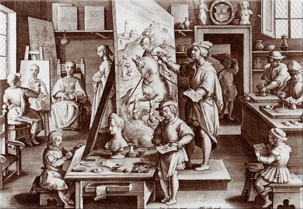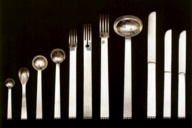
Examples of this first sense are depicted in:

Jan van der Straet (Stradanus) (Dutch, 1523-1604),
Painter's
Studio, woodcut.
As the master paints
a large canvas
with a picture of St.
George and the Dragon at the center, an apprentice
paints a portrait from a model at left, two make
drawings
and one mixes colors
in the foreground, two
more grind pigments into
oil on the right, and a
last one carries a canvas
toward the doorway. Windows let in natural light
from several angles. There
are numerous shelves, drawers and tables for supplies and works-in-progress.
See Dutch art, storage,
and studio.

Henri Matisse (French, 1869-1954), The Painter in His Studio or The Painter
and His Model, 1917, oil
on canvas, 146.5 x 97 cm,
Centre Georges Pompidou, Paris. See studio.

Pablo Picasso (Spanish, 1881-1973), Neo-Classical Painter in his Studio,
1963, etching,
41.9 x 57.1 cm, Tate Gallery, London. See easel,
Neoclassicism,
and studio.

Balthus (born Balthasar Klossowski de Rola)
(French, 1908-2001), The Painter and His Model, 1980-1981,
casein and tempera
on canvas, 226.5 x 230.5
cm, Georges Pompidou Center, Paris. See self-portrait.

Also, the preliminary form of a sculpture, building or other object created at a consistent
scale, often finished
in itself, but preceding the final casting
or carving. Or, a small-sized version of something,
such as the mannequin (small
wooden articulated figure) pictured
here. Architects make small
models of buildings with furnishings
and landscaping to show
clients how the finished product will look.
Examples of models of sculptures, architecture, and other three-dimensional
designs:

Egypt, Western Thebes, Model of a Riverboat, c. 1985 BCE,
Dynasty 12, early reign of Amenemhat I, Middle Kingdom, gessoed
and painted wood, linen twine,
linen, length
50 3/8 inches (128.9 cm), Metropolitan Museum of Art, NY. See Egyptian art.
Michelangelo Buonarroti (Italian, 1475-1564), Model for a Victory, also known as Hercules and Cacus (Ercole e Caco), c. 1508?, clay, height 26 1/2 inches (41 cm), Casa Buonarroti, Florence.

Annibale Fontana (Italian, Milan, 1540[?]-87), Adoring Angel, 1583-84, wax with metal armature on wood base, height (with base) 21 3/4 inches (55.2 cm), Los Angeles County Museum of Art.

Francois Girardon (French, 1628-1715), Model for the Equestrian Statue of Louis XIV,
bronze, Hermitage Museum, St.
Petersburg, Russia. See Baroque
and equestrian statue.

Frank Lloyd Wright (American, 1867-1959), Model of Fallingwater, Edgar J. Kaufmann House, Mill Run, Pennsylvania, 1934-37, acrylic, wood, metal, expanded polystyrene, and paint, 40 1/2 x 71 1/2 x 47 5/8 inches (102.9 x 181.6 x 121 cm), Museum of Modern Art, NY.

Josef Hoffmann (Austrian, 1870-1956) for Wiener Werkstätte, part of the Flat Model cutlery set, silver, c.1903-1904. "Model" in this instance, means "version." See secession.

Le Corbusier (born Charles-Edouard Jeanneret)
(French, born Switzerland, 1887-1965), Unité d'habitation, Berlin-Tiergaten,
1957-1958, maquette d'étude
(study model) of wood (solid
and sheet), 55 x 122 x 90 cm, Georges Pompidou Center, Paris.

Naum Gabo (worked in Germany, England, and
USA, born Russia, 1890-1977), Model for 'Constructed Torso', 1917,
reassembled 1981, cardboard,
39.5 x 29.0 x 16.0 cm, Tate Gallery, London. See model.

Naum Gabo, Model for 'Column', 1920-21, cellulose
nitrate, 14.3 x 9.5 x 9.5 cm, Tate Gallery, London.

Naum Gabo, Model for 'Rotating Fountain', 1925,
reassembled 1986, metal
and plastic, 44.0 x 40.0
x 40.0 cm, Tate Gallery, London. This model
was enlarged into a full-scale fountain, presumably
with curved, rotating
arms. Originally sited
in a Dresden garden, it is now destroyed.
See Constructivism, fountain, and
kinetic.


Matti Suuronen (Finnish architect, 1933-), Futuro, 1968, a "futuristic" house resembling a
 flying saucer, it has a fiberglass exterior, height 4 m, diameter 8 m, volume 140 cubic m, weight without furnishings, 2,500 kg, manufactured in several locations around the world.
flying saucer, it has a fiberglass exterior, height 4 m, diameter 8 m, volume 140 cubic m, weight without furnishings, 2,500 kg, manufactured in several locations around the world.Here is a model of the Futuro. It appears ovoid in every elevation view, although it is circular in plan. The shape is repeated in the design's twelve oval windows. Visit Futuro-House.net.
Or, to make by shaping a plastic substance, such as clay -- either modeling clay or ceramic clay — or wax. Also see maquette and modeling. (In this sense, it is much more appropriate to use the term model than it is to use the term mold — a common mistake.)
Also see architecture, attribute, full-scale, interdisciplinary, mannequin, placeholder, statue, and straight.
https://inform.quest/_art